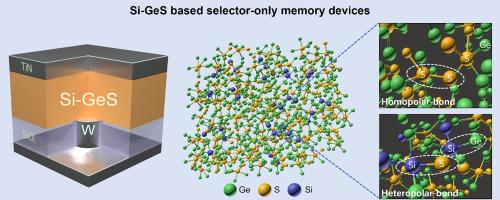Improved reliability of Si-doped GeS-based selector-only memory via homopolar bond suppression and enhanced memory window
IF 14.3
1区 材料科学
Q1 MATERIALS SCIENCE, MULTIDISCIPLINARY
引用次数: 0
Abstract
Selector-only memory (SOM) devices have emerged as promising candidates for next-generation memory technologies. Their unique architecture enables cross-point array integration without requiring an external selector, while offering faster operation speeds and lower power consumption compared to conventional storage-class memory (SCM) devices. Despite these advantages, amorphous chalcogenide-based SOM devices face several challenges that hinder commercialization, including poor thermal stability, threshold voltage (Vth) drift, a limited memory window, and degradation in electrical performance. In this study, we address these limitations by systematically investigating charge trapping phenomena based on the Poole–Frenkel conduction mechanism. We also compare the material properties of previously reported chalcogenide compounds to guide the design of a high-performance SOM device. GeS was selected as the active material due to its higher bonding energy and lower trap density compared to GeTe and GeSe. To further enhance device performance, Si doping was employed to suppress unstable S–S homopolar bonds, thereby reinforcing the amorphous network and improving both endurance and the memory window. The resulting Si-doped GeS-based SOM device exhibited excellent endurance (> 2 × 108 cycles) and long retention times (> 107 s), attributed to improved structural integrity through strong Si–S covalent bonding. The reduction in trap density also led to an increased threshold voltage in the RESET state, enabling a wide memory window (ΔVth ≈ 2.3 V). Moreover, by modulating pulse width (50–500 ns), we successfully demonstrated 2-bit multi-level cell (MLC) operation. These findings highlight that the Si-doped GeS-based SOM device combines low power consumption (≈ 50 pJ/bit), fast switching speed (≈ 100 ns), high endurance, and a wide memory window. This positions it as a strong candidate for next-generation compute express link-based SCM applications.

通过抑制同极性键和增强记忆窗口提高硅掺杂锗基选择器记忆的可靠性
仅选择器存储器(SOM)器件已成为下一代存储器技术的有前途的候选者。其独特的架构无需外部选择器即可实现跨点阵列集成,同时与传统的存储级内存(SCM)设备相比,具有更快的操作速度和更低的功耗。尽管有这些优点,基于非晶硫族化物的SOM器件仍面临着一些阻碍商业化的挑战,包括热稳定性差、阈值电压(Vth)漂移、有限的存储窗口和电气性能下降。在这项研究中,我们通过系统地研究基于普尔-弗伦克尔传导机制的电荷捕获现象来解决这些限制。我们还比较了以前报道的硫系化合物的材料性质,以指导高性能SOM器件的设计。与GeTe和GeSe相比,选择GeS作为活性材料是因为其具有更高的键能和更低的陷阱密度。为了进一步提高器件性能,采用Si掺杂抑制不稳定的S-S均极键,从而增强非晶网络,提高续航时间和记忆窗口。由于Si-S共价键提高了结构的完整性,硅掺杂的ge基SOM器件表现出优异的续航能力(>; 2 × 108次循环)和较长的保持时间(> 107 s)。陷阱密度的降低也导致复位状态下阈值电压的增加,从而实现宽的存储窗口(ΔVth≈2.3 V)。此外,通过调制脉冲宽度(50-500 ns),我们成功地演示了2位多级单元(MLC)操作。这些发现强调了si掺杂的基于ge的SOM器件具有低功耗(≈50 pJ/bit),快速开关速度(≈100 ns),高耐用性和宽存储窗口的特点。这使它成为下一代基于链路的计算快速SCM应用程序的有力候选。
本文章由计算机程序翻译,如有差异,请以英文原文为准。
求助全文
约1分钟内获得全文
求助全文
来源期刊

Journal of Materials Science & Technology
工程技术-材料科学:综合
CiteScore
20.00
自引率
11.00%
发文量
995
审稿时长
13 days
期刊介绍:
Journal of Materials Science & Technology strives to promote global collaboration in the field of materials science and technology. It primarily publishes original research papers, invited review articles, letters, research notes, and summaries of scientific achievements. The journal covers a wide range of materials science and technology topics, including metallic materials, inorganic nonmetallic materials, and composite materials.
 求助内容:
求助内容: 应助结果提醒方式:
应助结果提醒方式:


